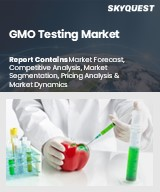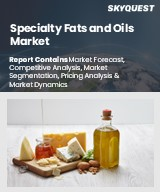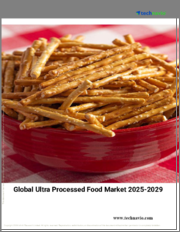
|
시장보고서
상품코드
1649417
세계의 가공식품 시장 - 예측(2025-2030년)Global Processed Food Market - Forecasts from 2025 to 2030 |
||||||
세계 가공식품 시장은 연평균 4.45%로 성장하여 2025년 2조 1,577억 6,100만 달러에서 2030년 2조 6,831억 6,400만 달러에 달할 것으로 예측됩니다.
가공식품은 조리, 냉동, 통조림 또는 보존 기간, 맛, 편의성을 높이기 위해 방부제나 기타 성분을 첨가하는 등의 방법을 통해 자연 상태에서 변형된 식품을 말합니다. 냉동 채소나 잘게 자른 과일과 같이 최소한의 가공을 거친 것부터 통조림 수프, 포장된 스낵, 설탕이 들어간 음료와 같이 다량의 가공을 거친 것까지 다양한 식품이 있습니다. 초가공 식품에는 인공 첨가물과 방부제가 많이 들어있는 경우가 많으며, 원재료가 거의 존재하지 않을 정도로 정제된 경우가 많습니다. 가공식품의 가장 큰 장점은 편리하다는 점이지만, 일반적으로 영양가가 낮고 과식하면 비만과 심장 관련 문제를 일으킬 수 있습니다.
세계 가공식품 시장의 주요 촉진요인:
- 편리성에 대한 요구 증가 : 바쁜 일상으로 인해 빠르고 간편하게 조리할 수 있는 간편식 솔루션에 대한 수요가 증가하고 있습니다. 도시화, 식품 가공 기술의 발전, 포장의 혁신, 라이프스타일의 변화 등으로 인해 보다 저렴하고 쉽게 구할 수 있으며 유통기한이 긴 가공식품이 부상하고 있습니다. 또한, 가처분 소득의 증가와 즉시 먹을 수 있고 휴대가 간편한 식품에 대한 선호도가 시장 성장을 견인하고 있습니다. 가공식품이 제공하는 다양성과 맛은 식품 브랜드의 세계화와 함께 전 세계적으로 그 매력을 더욱 확대시키고 있습니다.
- 통조림 및 냉동 방법의 인기 상승 : 필수 비타민과 미네랄이 풍부하고 보존성이 높은 고품질 식품을 섭취함으로써 건강한 라이프스타일을 추구하는 사람들이 늘어나고 있습니다. 이러한 추세로 인해 도시인들은 간편하고 편리한 식품을 선호하고 있습니다. 소비력 증가로 인해 다양한 통조림 식품의 인기가 높아지면서 식품 가공에서 통조림 기술에 대한 수요도 증가하고 있습니다.
또한, 바쁜 직장인들이 일주일 후의 식사를 준비하기 위해 냉동 가공이 인기를 끌고 있습니다. 냉동 과일과 채소는 섬세한 비타민과 영양소를 유지하면서 신선도를 오래 유지할 수 있기 때문에 시간이 부족한 사람들에게 매력적인 선택이 되고 있습니다.
가공식품 시장의 지리적 전망:
- 세계 세분화 : 세계 가공식품 시장은 북미, 남미, 유럽, 중동 및 아프리카, 아시아태평양 등 5개 지역으로 구분됩니다.
- 북미 : 이 지역은 가공식품의 고급 품종을 제공하는 기업이 증가함에 따라 예측 기간 동안 큰 점유율을 차지할 것으로 예상됩니다.
- 아시아태평양 : 아시아태평양은 각국 정부가 식음료 부문을 강화하기 위한 이니셔티브를 시행함에 따라 예측 기간 동안 시장 점유율이 크게 확대될 것으로 예상됩니다. 예를 들어, 인도의 식품 가공 시장 규모는 가처분 소득 증가와 도시화에 따른 소비자 기반 확대로 2022년 8,660억 달러에서 2027년 1조 2,740억 달러에 달할 것으로 예상됩니다.
인도 식품안전기준청(FSSAI)과 같은 당국의 엄격한 규제는 인도 및 기타 국가에서 판매되는 식품과 음료의 안전을 보장하고 있습니다. 또한 인도, 중국, 일본을 포함한 이 지역의 여러 국가에서 육류 및 해산물 소비가 눈에 띄게 증가하고 있습니다.
- 통찰력 있는 분석 : 고객 부문, 정부 정책 및 사회경제적 요인, 소비자 선호도, 산업별, 기타 하위 부문에 중점을 두고 주요 지역뿐만 아니라 신흥 지역까지 포괄하는 상세한 시장 인사이트를 얻을 수 있습니다.
- 경쟁 환경 : 세계 주요 기업들이 채택하고 있는 전략적 전략을 이해하고, 적절한 전략을 통한 시장 침투 가능성을 파악할 수 있습니다.
- 시장 동향과 촉진요인 : 역동적인 요인과 매우 중요한 시장 동향, 그리고 이들이 향후 시장 발전을 어떻게 형성할 것인지에 대해 알아봅니다.
- 실행 가능한 제안 : 역동적인 환경 속에서 새로운 비즈니스 스트림과 수익을 발굴하기 위한 전략적 의사결정을 내릴 수 있도록 인사이트를 활용합니다.
- 다양한 사용자에게 적합 : 스타트업, 연구기관, 컨설턴트, 중소기업, 대기업에 유익하고 비용 효율적입니다.
어떤 용도로 사용되는가?
산업 및 시장 검토, 사업 기회 평가, 제품 수요 예측, 시장 진입 전략, 지리적 확장, 설비 투자 결정, 규제 프레임워크 및 영향, 신제품 개발, 경쟁의 영향
조사 범위
- 2022년부터 2030년까지의 과거 데이터 및 전망
- 성장 기회, 도전 과제, 공급망 전망, 규제 프레임워크, 고객 행동 및 트렌드 분석
- 경쟁사 포지셔닝, 전략 및 시장 점유율 분석
- 수익 성장 및 예측 국가를 포함한 부문 및 지역 분석
- 기업 프로파일링(특히 주요 동향 등)
세계 가공식품 시장은 다음과 같이 세분화되어 있습니다:
가공 방법별
- 냉동
- 건조
- 통조림
- 소성
제품 유형별
- 조식용 시리얼
- 치즈 및 유제품
- 통조림 과일 및 채소
- 육제품
- 레디밀
- 케이크 및 비스킷
- 기타
유통 채널별
- 온라인
- 오프라인
지역별
- 북미
- 미국
- 캐나다
- 멕시코
- 남미
- 브라질
- 아르헨티나
- 기타 남미
- 유럽
- 영국
- 독일
- 프랑스
- 이탈리아
- 스페인
- 기타 남미
- 중동 및 아프리카
- 사우디아라비아
- UAE
- 기타 중동 및 아프리카
- 아시아태평양
- 중국
- 인도
- 일본
- 한국
- 대만
- 태국
- 인도네시아
- 기타 아시아태평양
목차
제1장 소개
- 시장 개요
- 시장 정의
- 조사 범위
- 시장 세분화
- 통화
- 가정
- 기준 연도와 예측 연도 타임라인
- 이해관계자에 대한 주요 이점
제2장 조사 방법
- 조사 설계
- 조사 과정
제3장 주요 요약
- 주요 조사 결과
- 애널리스트의 견해
제4장 시장 역학
- 시장 성장 촉진요인
- 시장 성장 억제요인
- Porter's Five Forces 분석
- 업계 밸류체인 분석
제5장 세계의 가공식품 시장 : 가공 방법별
- 소개
- 냉동
- 건조
- 통조림
- 소성
제6장 세계의 가공식품 시장 : 제품 유형별
- 소개
- 아침식사용 시리얼
- 치즈·유제품
- 통조림 야채·과일
- 육제품
- 레디밀
- 케이크·비스킷
- 기타
제7장 세계의 가공식품 시장 : 유통 채널별
- 소개
- 온라인
- 오프라인
제8장 세계의 가공식품 시장 : 지역별
- 세계 개요
- 북미
- 미국
- 캐나다
- 멕시코
- 남미
- 브라질
- 아르헨티나
- 기타 남미
- 유럽
- 영국
- 독일
- 프랑스
- 이탈리아
- 스페인
- 기타 유럽
- 중동 및 아프리카
- 사우디아라비아
- 아랍에미리트
- 기타 중동 및 아프리카
- 아시아태평양
- 중국
- 인도
- 일본
- 한국
- 대만
- 태국
- 인도네시아
- 기타 아시아태평양
제9장 경쟁 환경과 분석
- 주요 기업과 전략 분석
- 시장 점유율 분석
- 합병, 인수, 합의 및 협업
- 경쟁 대시보드
제10장 기업 개요
- Unilever
- Nestle SA
- The Kraft Heinz Company
- The J.M. Smucker Company
- CSC BRANDS, L.P.
- ADM
- Tyson Foods, Inc.
- Kellogg NA Co.
- Conagra Brands, Inc.
- Hormel Foods Corporation
The global processed food market is projected to grow at a CAGR of 4.45%, from US$2,157.761 billion in 2025 to US$2,683.164 billion in 2030.
Processed food refers to food that has been modified from its natural state through methods such as cooking, freezing, canning, or the addition of preservatives and other ingredients to enhance shelf life, flavor, or convenience. These foods range from minimally processed items like frozen vegetables and pre-cut fruits to heavily processed products such as canned soups, packaged snacks, and sugary beverages. Ultra-processed foods often contain numerous artificial additives and preservatives, making them so refined that whole ingredients are barely present. While convenience is a key benefit, processed foods generally provide lower nutritional value and can contribute to obesity and heart-related issues if consumed in excess.
Key Drivers of the Global Processed Food Market:
- Growing Demand for Convenience: The increasing busyness of consumers has led to a higher demand for convenient meal solutions that are quick and easy to prepare. Urbanization, advancements in food processing technology, innovations in packaging, and changing lifestyles are all contributing to the rise of processed foods that are more affordable, accessible, and long-lasting. Additionally, higher disposable incomes and a preference for ready-to-eat or on-the-go options continue to drive market growth. The variety and flavor offered by processed foods, coupled with the globalization of food brands, have further expanded their appeal worldwide.
- Rising Popularity of Canning and Freezing Methods: More individuals are becoming conscious of leading healthy lifestyles by consuming high-quality foods rich in essential vitamins and minerals that also have good shelf lives. This trend is prompting urban populations to favor easy and convenient food options. Increased spending power is also boosting the popularity of various canned foods and enhancing the demand for canning techniques in food processing.
Furthermore, frozen processing is gaining traction as busy professionals prepare meals for the week ahead. Frozen fruits and vegetables remain fresh longer while preserving sensitive vitamins and nutrients, making them an attractive option for those with limited time.
Geographical Outlook of the Processed Food Market:
- Global Segmentation: The global processed food market is divided into five regions: North America, South America, Europe, the Middle East and Africa, and Asia Pacific.
- North America: This region is expected to hold a significant share during the forecast period due to an increasing number of companies offering advanced varieties of processed foods. Additionally, there are rising investments in research and development aimed at improving processing techniques and equipment within the established food and beverage sector.
- Asia Pacific: The Asia Pacific region is projected to experience substantial growth in market share over the forecast period as governments implement initiatives to bolster the food and beverage sector. For example, India's food processing market size is anticipated to reach US$1,274 billion by 2027, up from US$866 billion in 2022, driven by a growing consumer base with rising disposable incomes and increasing urbanization.
Strict regulations from authorities like the Food Safety and Standards Authority of India (FSSAI) ensure the safety of foods and beverages sold in countries such as India. Additionally, there is a notable increase in meat and seafood consumption across various countries in this region, including India, China, and Japan.Reasons for buying this report:-
- Insightful Analysis: Gain detailed market insights covering major as well as emerging geographical regions, focusing on customer segments, government policies and socio-economic factors, consumer preferences, industry verticals, other sub- segments.
- Competitive Landscape: Understand the strategic maneuvers employed by key players globally to understand possible market penetration with the correct strategy.
- Market Drivers & Future Trends: Explore the dynamic factors and pivotal market trends and how they will shape up future market developments.
- Actionable Recommendations: Utilize the insights to exercise strategic decision to uncover new business streams and revenues in a dynamic environment.
- Caters to a Wide Audience: Beneficial and cost-effective for startups, research institutions, consultants, SMEs, and large enterprises.
What do businesses use our reports for?
Industry and Market Insights, Opportunity Assessment, Product Demand Forecasting, Market Entry Strategy, Geographical Expansion, Capital Investment Decisions, Regulatory Framework & Implications, New Product Development, Competitive Intelligence
Report Coverage:
- Historical data & forecasts from 2022 to 2030
- Growth Opportunities, Challenges, Supply Chain Outlook, Regulatory Framework, Customer Behaviour, and Trend Analysis
- Competitive Positioning, Strategies, and Market Share Analysis
- Revenue Growth and Forecast Assessment of segments and regions including countries
- Company Profiling (Strategies, Products, Financial Information, and Key Developments among others)
The Global Processed Food Market has been segmented as following:
By Processing Method
- Freezing
- Drying
- Canning
- Baking
By Product Type
- Breakfast Cereals
- Cheese and Dairy
- Canned Vegetables and Fruits
- Meat Products
- Ready Meals
- Cakes And Biscuits
- Others
By Distribution Channel
- Online
- Offline
By Geography
- North America
- USA
- Canada
- Mexico
- South America
- Brazil
- Argentina
- Rest of South America
- Europe
- United Kingdom
- Germany
- France
- Italy
- Spain
- Rest of Europe
- Middle East and Africa
- Saudi Arabia
- UAE
- Rest of the Middle East and Africa
- Asia Pacific
- China
- India
- Japan
- South Korea
- Taiwan
- Thailand
- Indonesia
- Rest of Asia-Pacific
TABLE OF CONTENTS
1. INTRODUCTION
- 1.1. Market Overview
- 1.2. Market Definition
- 1.3. Scope of the Study
- 1.4. Market Segmentation
- 1.5. Currency
- 1.6. Assumptions
- 1.7. Base and Forecast Years Timeline
- 1.8. Key benefits for the stakeholders
2. RESEARCH METHODOLOGY
- 2.1. Research Design
- 2.2. Research Process
3. EXECUTIVE SUMMARY
- 3.1. Key Findings
- 3.2. Analyst View
4. MARKET DYNAMICS
- 4.1. Market Drivers
- 4.2. Market Restraints
- 4.3. Porter's Five Forces Analysis
- 4.3.1. Bargaining Power of Suppliers
- 4.3.2. Bargaining Power of Buyers
- 4.3.3. The Threat of New Entrants
- 4.3.4. Threat of Substitutes
- 4.3.5. Competitive Rivalry in the Industry
- 4.4. Industry Value Chain Analysis
5. GLOBAL PROCESSED FOOD MARKET BY PROCESSING METHOD
- 5.1. Introduction
- 5.2. Freezing
- 5.3. Drying
- 5.4. Canning
- 5.5. Baking
6. GLOBAL PROCESSED FOOD MARKET BY PRODUCT TYPE
- 6.1. Introduction
- 6.2. Breakfast Cereals
- 6.3. Cheese and Dairy
- 6.4. Canned Vegetables and Fruits
- 6.5. Meat Products
- 6.6. Ready Meals
- 6.7. Cakes And Biscuits
- 6.8. Others
7. GLOBAL PROCESSED FOOD MARKET BY DISTRIBUTION CHANNEL
- 7.1. Introduction
- 7.2. Online
- 7.3. Offline
8. GLOBAL PROCESSED FOOD MARKET BY GEOGRAPHY
- 8.1. Global Overview
- 8.2. North America
- 8.2.1. United States
- 8.2.2. Canada
- 8.2.3. Mexico
- 8.3. South America
- 8.3.1. Brazil
- 8.3.2. Argentina
- 8.3.3. Rest of South America
- 8.4. Europe
- 8.4.1. United Kingdom
- 8.4.2. Germany
- 8.4.3. France
- 8.4.4. Italy
- 8.4.5. Spain
- 8.4.6. Rest of Europe
- 8.5. Middle East and Africa
- 8.5.1. Saudi Arabia
- 8.5.2. United Arab Emirates
- 8.5.3. Rest of the Middle East and Africa
- 8.6. Asia-Pacific
- 8.6.1. China
- 8.6.2. India
- 8.6.3. Japan
- 8.6.4. South Korea
- 8.6.5. Taiwan
- 8.6.6. Thailand
- 8.6.7. Indonesia
- 8.6.8. Rest of Asia-Pacific
9. COMPETITIVE ENVIRONMENT AND ANALYSIS
- 9.1. Major Players and Strategy Analysis
- 9.2. Market Share Analysis
- 9.3. Mergers, Acquisitions, Agreements, and Collaborations
- 9.4. Competitive Dashboard
10. COMPANY PROFILES
- 10.1. Unilever
- 10.2. Nestle SA
- 10.3. The Kraft Heinz Company
- 10.4. The J.M. Smucker Company
- 10.5. CSC BRANDS, L.P.
- 10.6. ADM
- 10.7. Tyson Foods, Inc.
- 10.8. Kellogg NA Co.
- 10.9. Conagra Brands, Inc.
- 10.10. Hormel Foods Corporation



















